Anchovies are a favourite food for New Zealand kahawai. Kahawai are highly selective when feeding on juvenile anchovies - which are skinny 4-6cm long translucent baitfish with pearlescent bellies, silver lateral stripes, and prominent eyes.
Searching for a solution for these fussy anchovy feeders I turned to Bob Popovic’s famous Surf Candy.
With my size 4 version looking just like the little baitfish I retrieved from the stomachs of the kahawai we had eaten, I was convinced I had cracked the code.
But in the water the stiff Super Hair tails lacked movement and a considerable mass of epoxy produced the dreaded jig action kahawai seem to abhor, and also caused flies tied on small light wire hooks to swim on their sides.
Once again more follows and fewer hook ups than I felt I deserved. My Surf Candies were also not very durable, sometimes cracking when I twisted them out of the jaws of large fish or when the fly clipped the kayak on an errant cast.
To improve on the Surf Candy as a juvenile anchovy imitation, I tied the first Jelly Belly Minnow back in 2008. It evolved over the next three seasons, largely through a process of kahawai selection, and it is now my stand-out favourite small baitfish imitation.
Built on a foundation of tough, flexible Stretch Cord, with a modicum of epoxy, the Jelly Belly Minnow has an attractive sparkle-belly, and does not sink as quickly as the Surf Candy.
I've caught hundreds of fish on the Jelly Belly Minnow but have yet to have one break or come apart.
When imitating anchovies I prefer to tie the Jelly Belly Minnow on 1x or 2x long shank hooks as they produce pearlescent bellies of more realistic proportion, than hook shanks of standard length.
Owing to the small amount epoxy used, and the fact that it is distributed evenly around the hook shank, this design will, unlike the Surf Candy, swim upright when tied on a light wire straight eye hook.
To imitate the small freshwater smelt of the North Island lakes I tie the Jelly Belly Minnow on a silver 3x long shank hook with straight eye (e.g. TMC 9394). Smelt have longer bellies than anchovies, and the proportionately shorter tail of the smelt version should result in more hook-ups with tail-nipping trout.
The best wing material for the Jelly Belly Minnow is Unique Hair. Being the finest of the crinkly nylon hairs, the fibres stick together underwater forming a consolidated translucent wing/body on small patterns, which are also less prone to fouling when casting or fighting fish.
The most natural colour combinations for the Jelly Belly Minnow are tan, grey or olive over smoke Unique Hair, with a clear Stretch Cord abdomen. There are days, however, when flies that stand out from the crowd have a decided edge. Chartreuse Unique Hair, with its strong fibre optic properties, actually glows slightly in low light; as does pink Stretch Cord. The Tutti Frutti Jelly Belly Minnow, with chartreuse over smoke wing and pink Stretch Cord belly, is absolutely deadly at times, especially in discoloured water or low light.
The Jelly Belly Minnow seems most effective on fussy kahawai when flash is used sparsely. As the silver lateral stripes and pearlescent belly of juvenile anchovies become more prominent as they grow, it makes sense to increase the use of flash with size. In addition to adding a few more strands of flash to the wing of the size 4 Jelly Belly Minnow, I also like to wind a strand of Accent Flash or fine tinsel between the turns of Stretch Cord to accentuate the pearlescent belly and enhance the illusion of movement in the water.
Spiral mylar such as Accent Flash or Krystal Flash is more durable in wings than flat, invariably softer materials like Polar flash and Flashabou, and is also less prone to fouling. I tend to shy away from pearl flash materials for the wings of natural Jelly Belly Minnows as, regardless of the colour, the pearl flash emits an unnatural green sparkle under water.
Epoxy glues and light cured acrylic resins both work well on the JBN. Discolouration of the resin is less of an issue with this pattern than it is with the Surf Candy, as the Stretch Cord core ensures the belly remains reasonably clear and reflective, even if the epoxy coating yellows. Another advantage of the Jelly Belly Minnow over the Surf Candy, when using two part epoxy is that only one coat is required, which halves the curing time and requires less sculpturing skill.
Light cured acrylic resins make for an even quicker tie, as they set the instant they are exposed to the blue/UV torch, or to sunlight. The thinner, less viscous acrylic resins tend to work best on the Jelly Belly Minnow. “Tack Free Brush” produced by Clear Cure Goo is extremely tough and impact resistant, and works very well on this pattern. (The “Tack Free” in the syringe is more viscous and more difficult to work with).
I like to finish each fly with a coat of Salley Hansen’s Hard as Nails, regardless of the type of resin used. Besides producing a more “finished” fly, the varnish removes the slightly tacky surface of freshly cured epoxy and acrylic resins. Salley Hansen’s may also be used with great effect to restore flies abraded by teeth.
Although the Jelly Belly Minnow was developed with juvenile anchovies in mind, it makes a good imitation of any small skinny baitfish; including smelt, juvenile sardines and fresh water white bait. Having evolved to meet the exacting standards of sharp-eyed kahawai, the Jelly Belly Minnow has proven effective on other game fish selectively feeding on small bait - including tunas and sea trout. Small Jelly Belly Minnows with pink bellies have also worked on fussy krill feeding kahawai.
Recipe
Hook: Mustard S71Z-34007 or other 1X long shank hook, sizes 8 to 4.
Thread: Ultra fine clear mono
Belly: Stretch Cord (clear for natural and pink for Tutti Frutti): 0.8mm for sizes 6-8 and 1.0mm for size 4
Rib(optional): Fine silver mylar, wound between turns of stretch cord belly
Wing: Unique Hair: Tan, olive or chartreuse over smoke
Flash: 2-4 strands of silver spiral mylar.
Eye: Prismatic eyes, 3mm for sizes 6-4, and 2mm for size 8
Resin: Light cured acrylic or 5 minute epoxy resin
Tying Steps
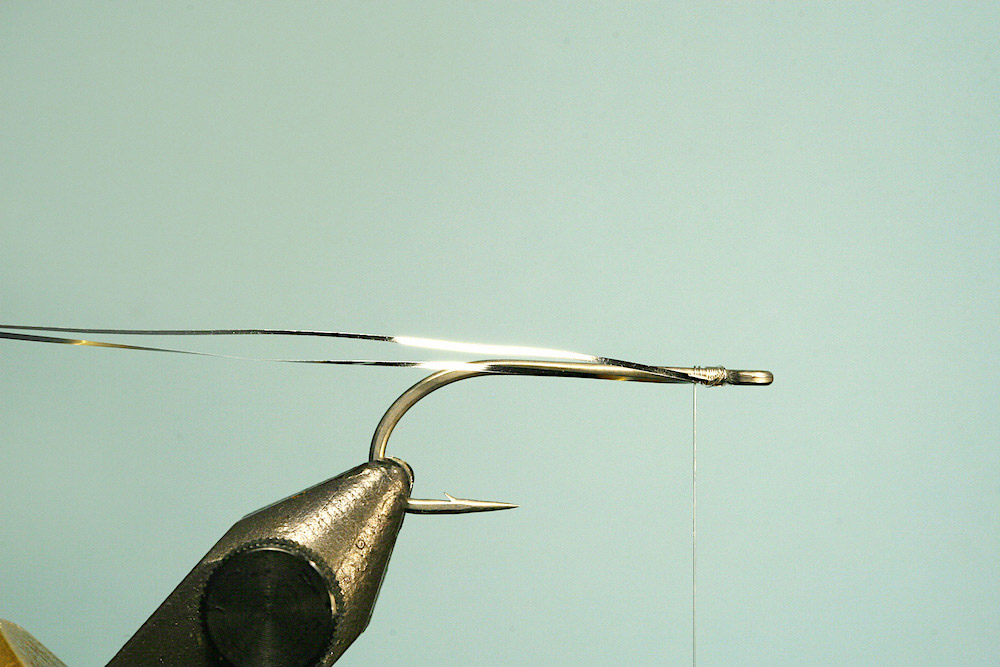
Step 1
Attach thread just behind the hook eye and tie in two strands of silver Flashabou.
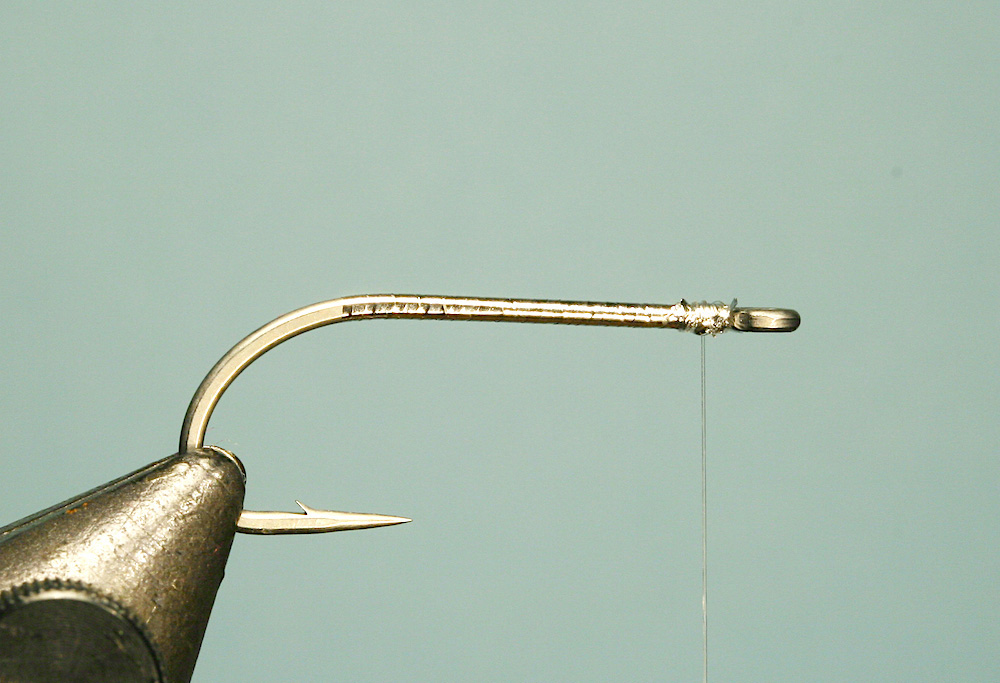
Step 2
Wind the Flashabou rearward in closed turns to the hook bend, and then back to the eye, and tie off.
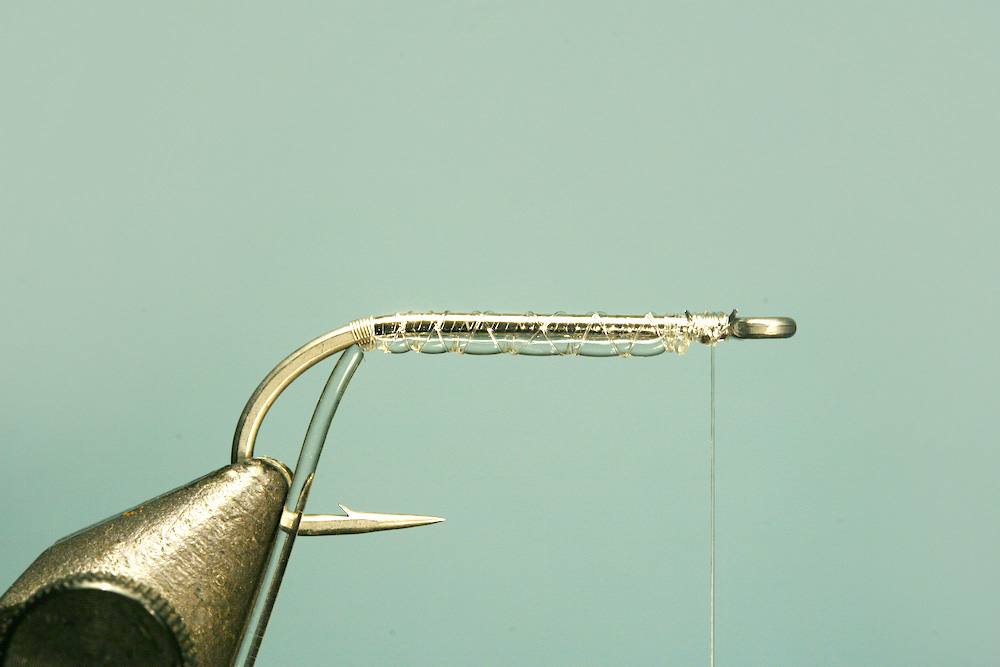
Step 3
Tie the Stretch Cord in beneath the hook shank, about one eye length behind the eye. Now lash it to the hook shank with large open turns, making five or six tight turns at the hook bend, before returning the thread in open turns to the hook eye.
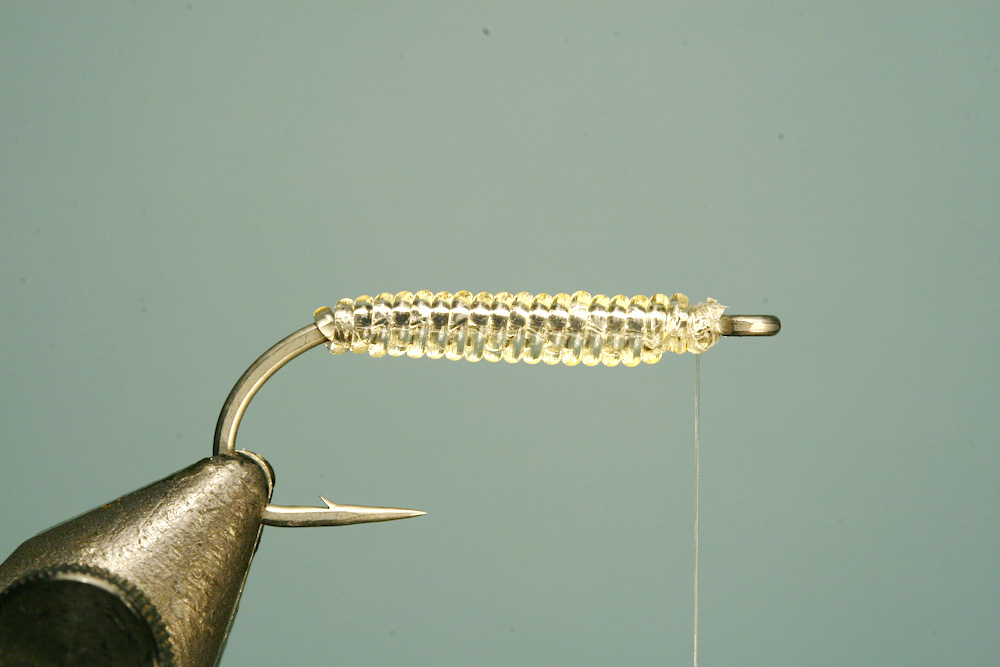
Step 4
Wrap the Stretch Cord forward in closed turns, reducing tension to create a tapered abdomen. Tie off behind the hook eye.
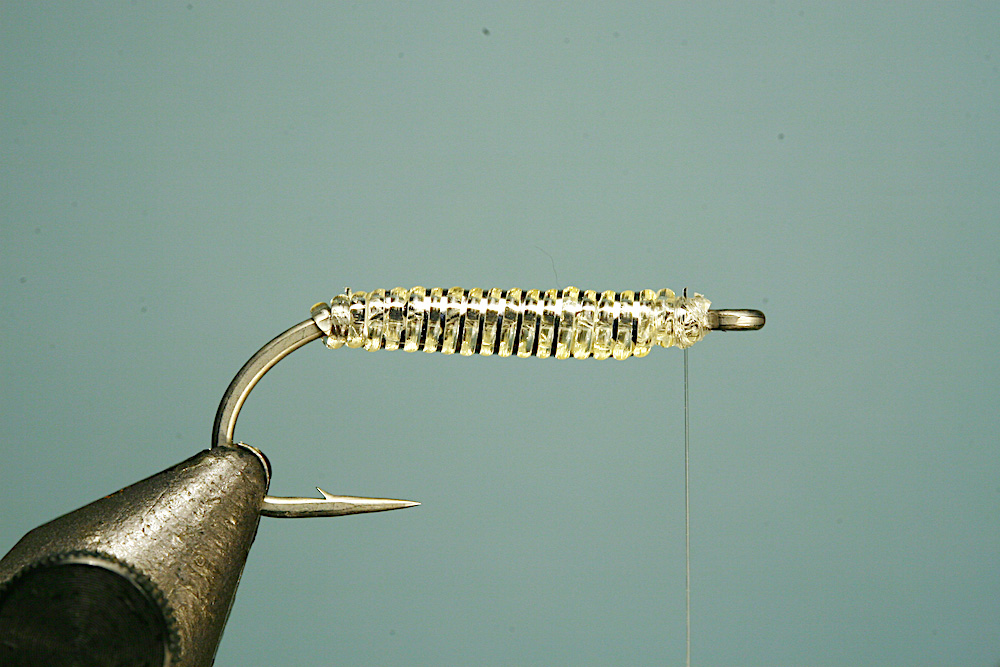
Step 5
Wedge a strand of Midge Flash or fine tinsel between turns of Stretch Cord at the rear of the belly, and then wind the flash forward between turns of Stretch Cord, tying it off at the hook eye. This is an optional step I usually use on larger Jelly Belly Minnows.
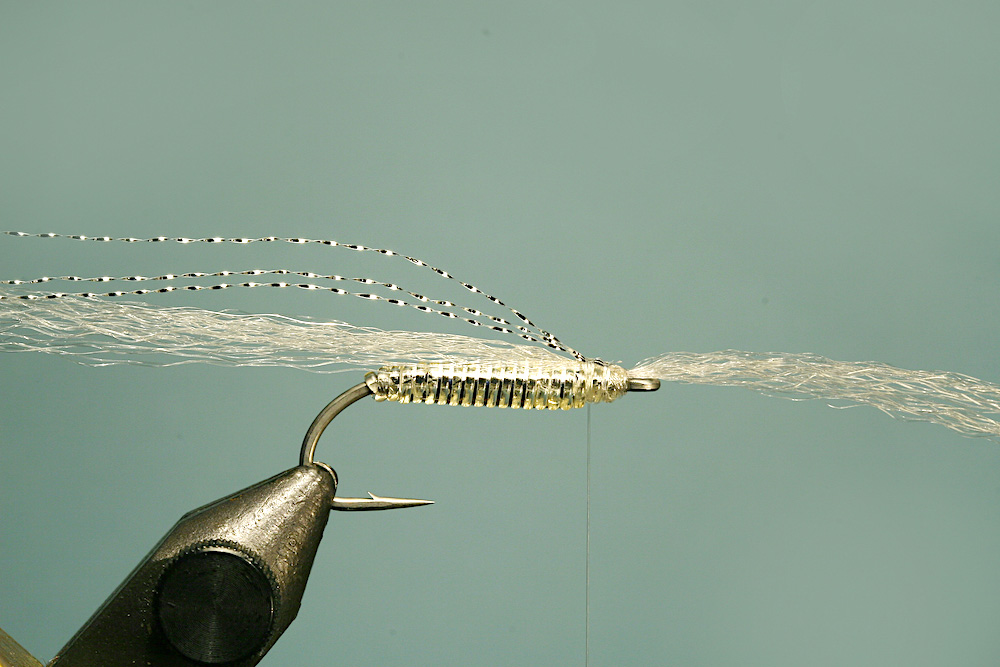
Step 6
Select a bunch of smoke Unique Hair about six times the length of the hook shank (half the standard hank length is usually fine). Now tie this in at the middle, just behind the hook eye. Next tie in a few strands of silver flash.
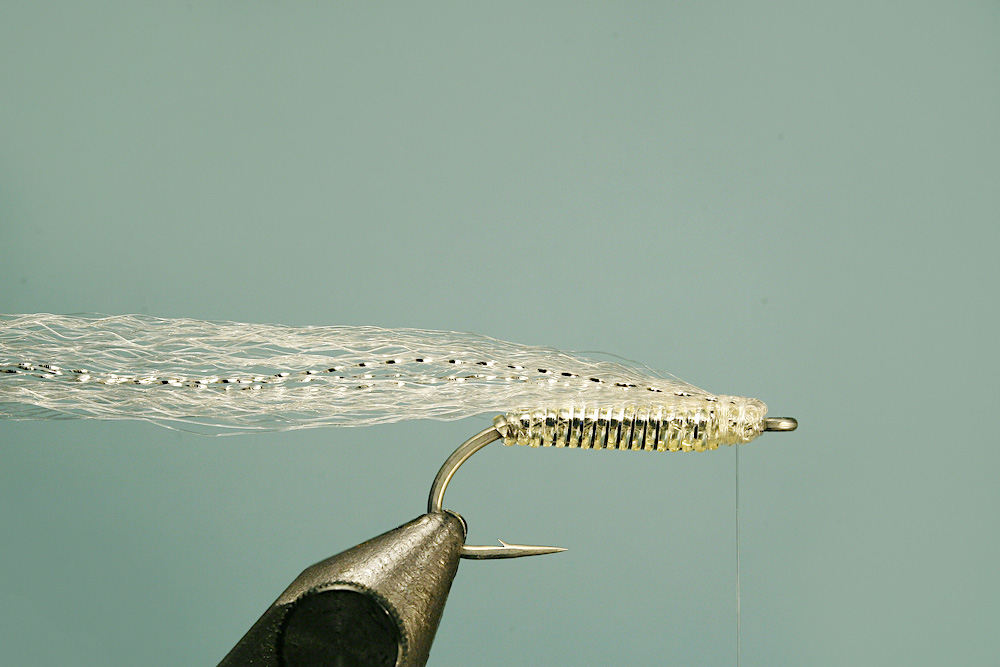
Step 7
Fold the forward projecting Unique Hair back, and tie it down.
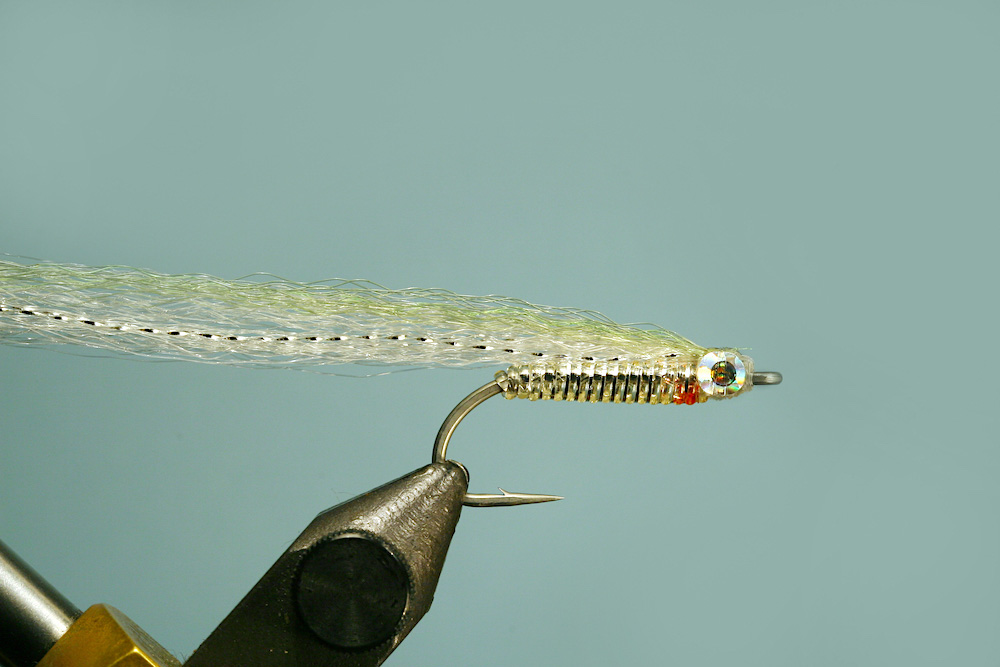
Step 8
Tie in an over-wing of olive or tan Unique Hair. Now stick prismatic eyes on to the thread wraps on either side of the “head”, securing them with an additional two turns of thread (this will stop the eyes moving about when the resin is applied). Tie off with thee half hitches and apply a micro drop of super glue to the thread beneath the head. Finally apply a dab of red marker to the Stretch Cord just behind the eyes to simulate gills.
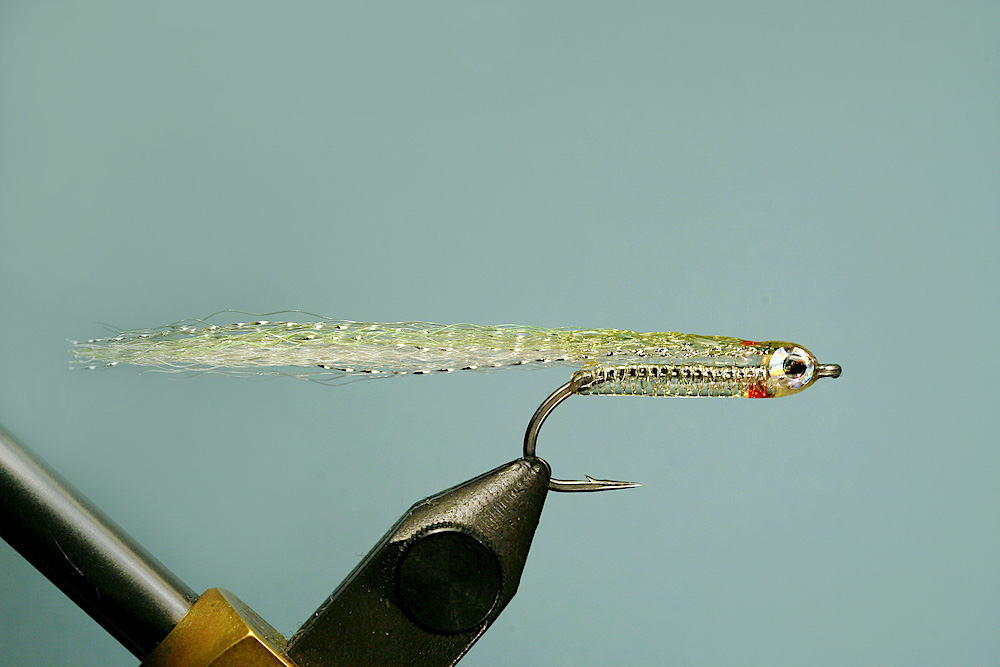
Step 9
Thinly coat the head and abdomen with resin, ensuring the wing is saturated. Once the resin has cured, trim the tail portion of the wing with a pair of scissors so that it is about three times the shank length, and tapers to a point (for shank lengths 2X and 3X long, trim to two and one shank lengths, respectively). To finish the fly, coat the resin with Salley Hansens Hard as Nails.
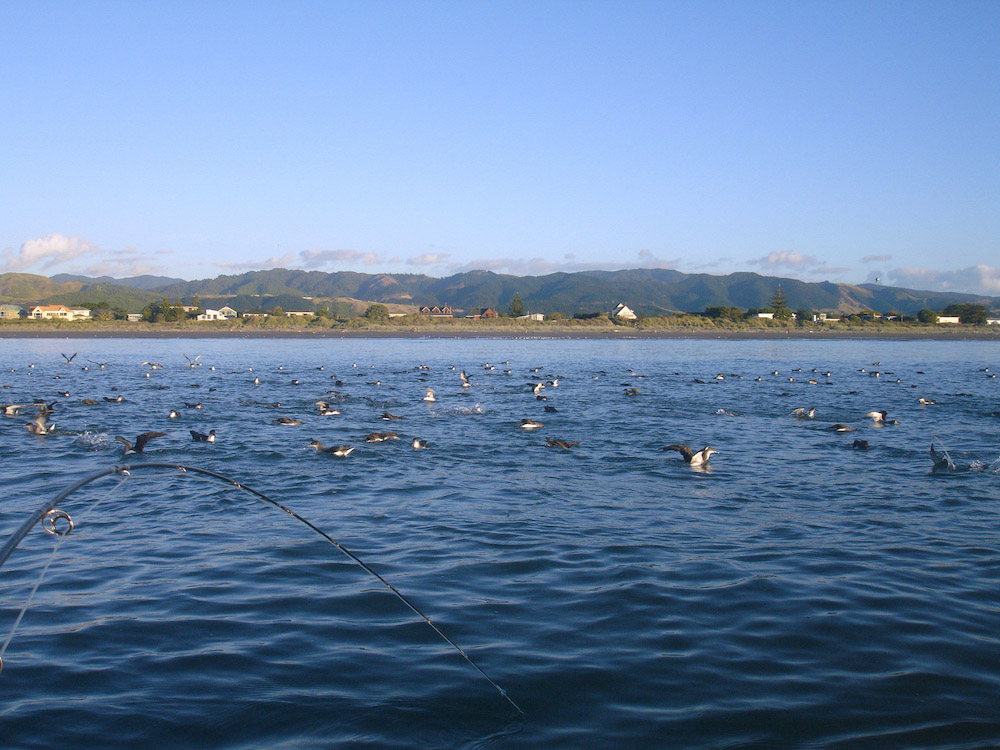
Kahawai herd a large school of juvenile anchovies to the surface
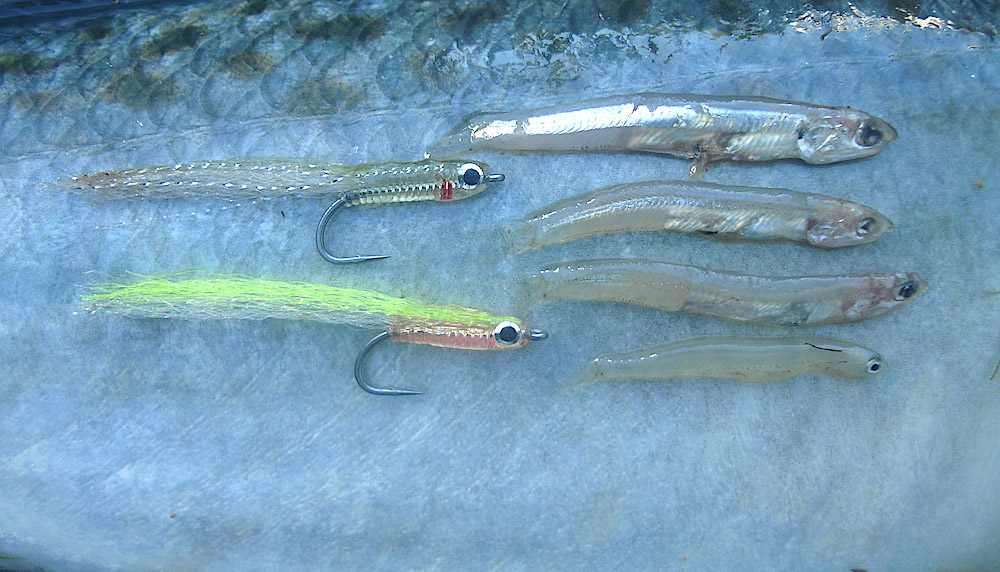
Three sizes of juvenile anchovy from a kahawai's stomach. Note how the silver lateral strips and pearlescent belly develop with growth. Size 6 Jelly Belly Minnows provided for scale
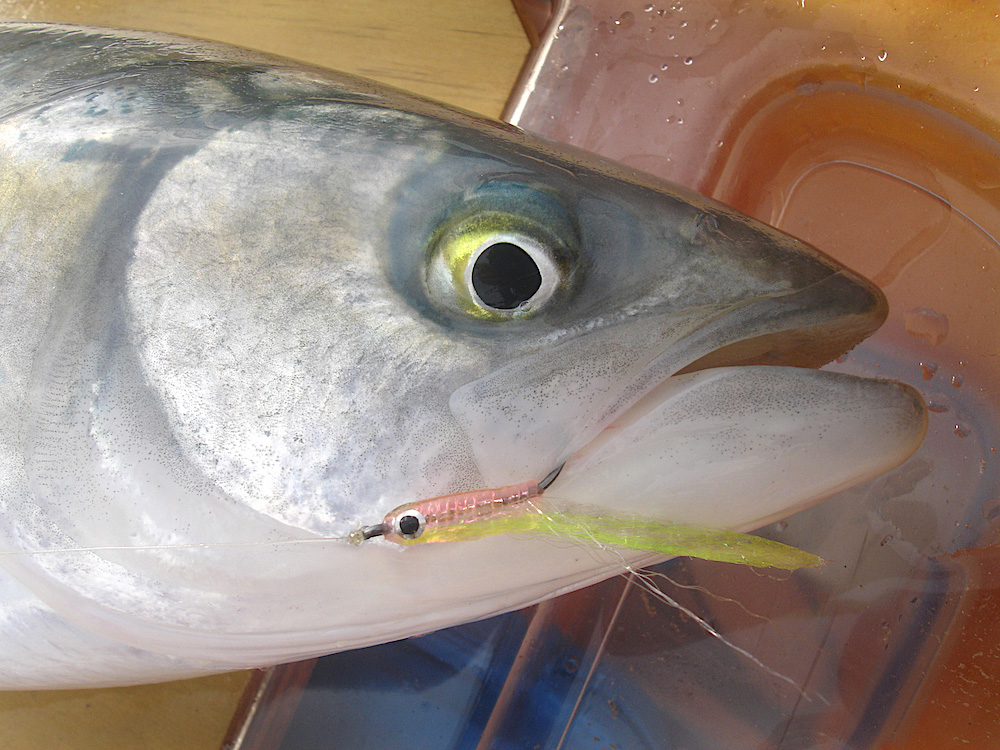
The Tutti Frutti Jelly Belly Minnow strikes again
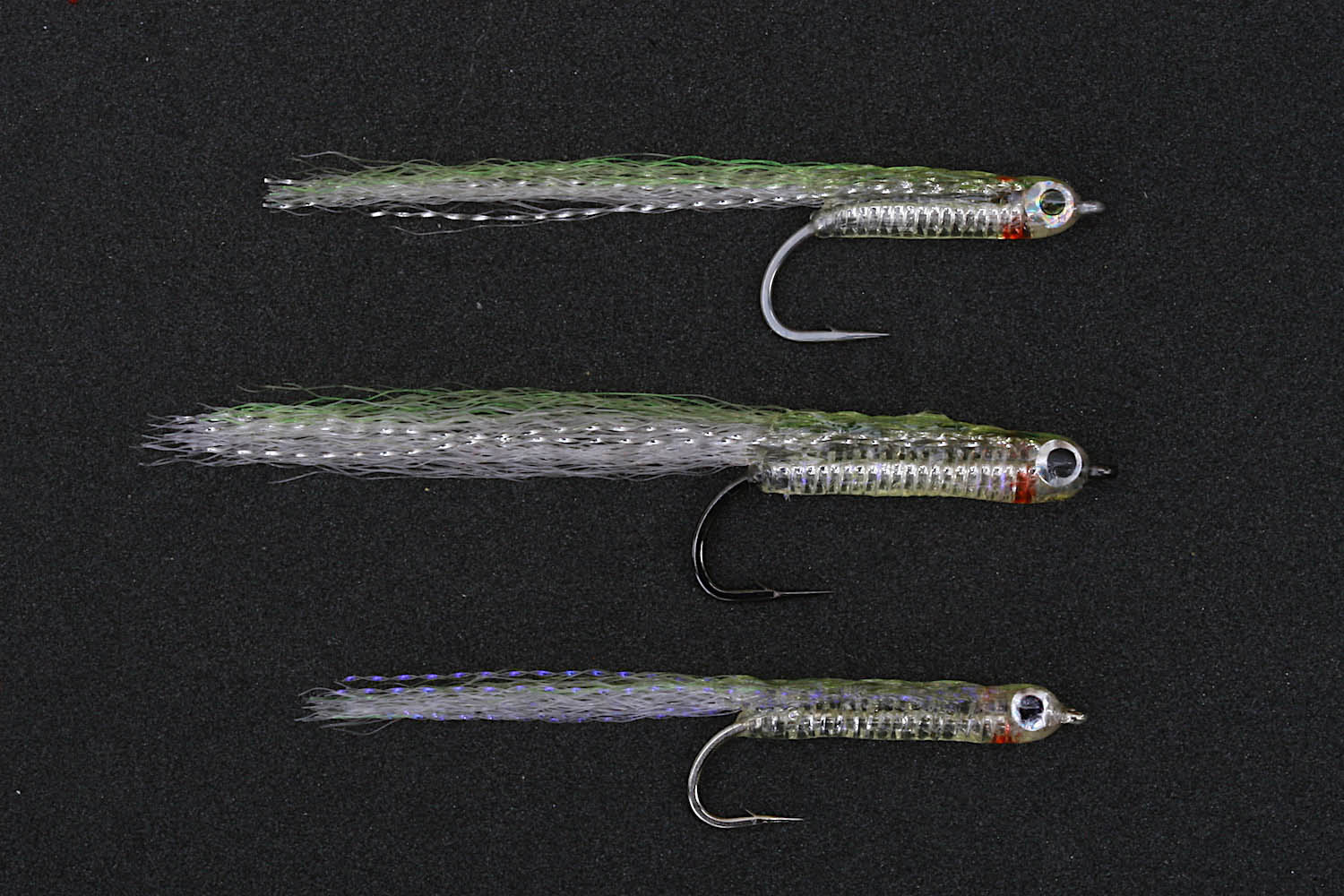
Jelly Belly Minnows tied on 1x, 2x and 3x long shank hooks
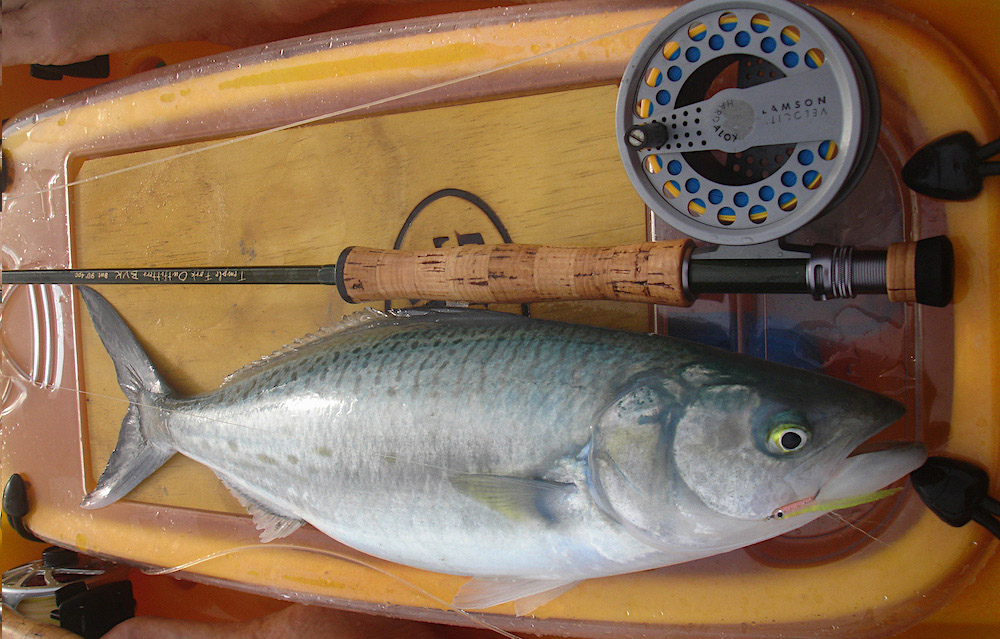
A handsome victim of the Jelly Belly Minnow
+ Effective Spey flies for New Zealand Trout and techniques for fishing them
+ Evolution of the Swing Minnow - A deadly Trout Spey Streamer
+ Introduction to wonders of Stretch Cord
+ Jelly Midge
+ Jelly Bloodworm and Jelly Grub
+ Jelly Caddis
+ Jelly Leg Colly
+ Jelly Crimp Nymph
+ Hot Foam Hopper
+ Hare's Mask Darter
+ Silicone Wing Cicada - Designing the Fly
+ Silicone Wing Cicada - Tying Steps
+ Gurgle Pop Minnow
+ Cutting your own Foam Cylinder
